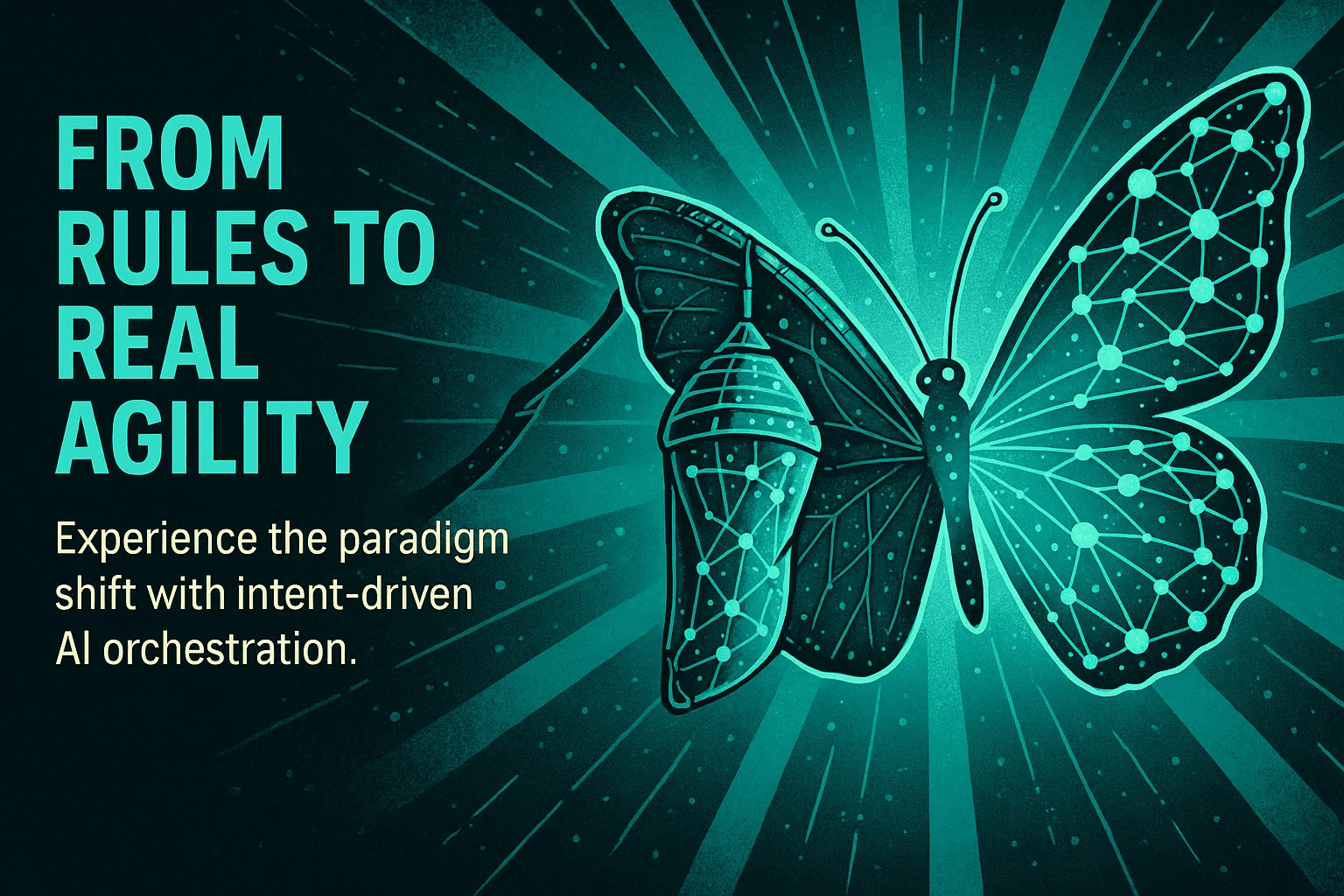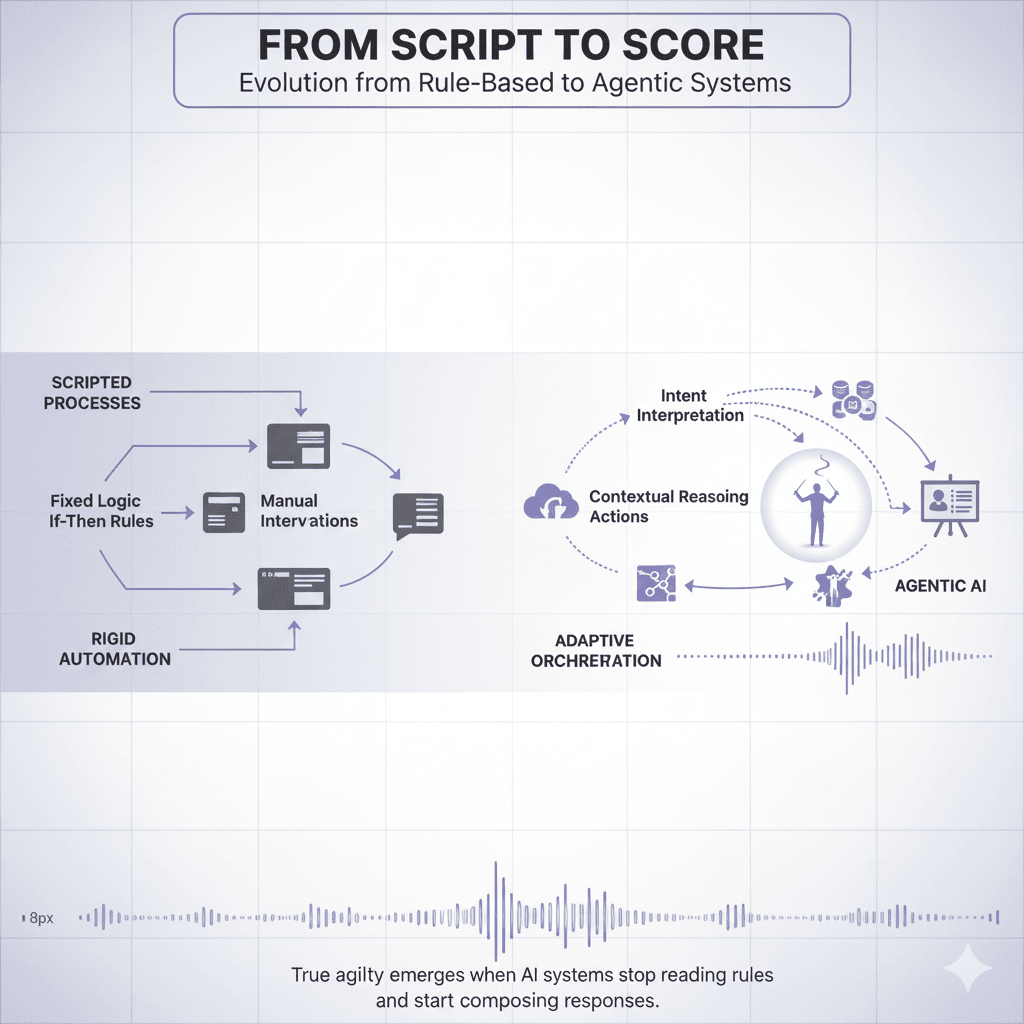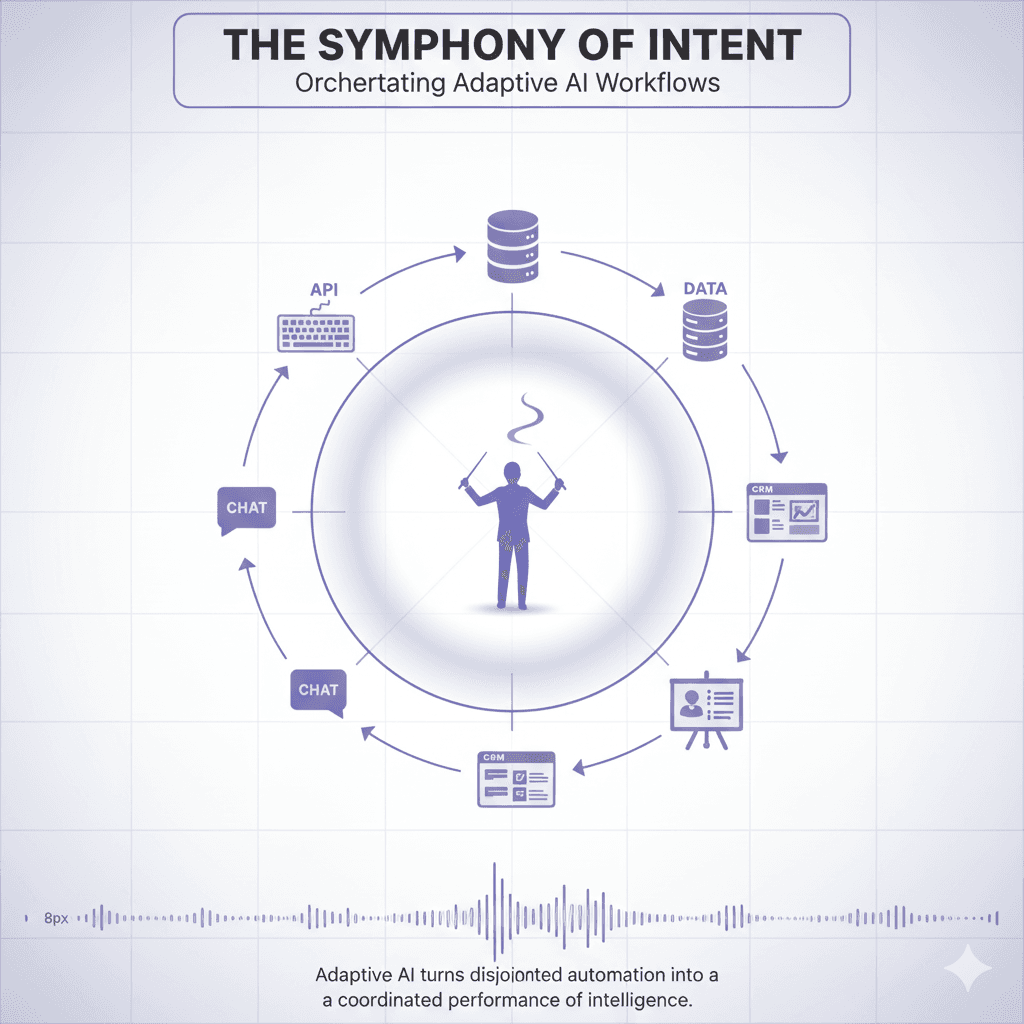Workflow Automation Defined and Its Evolution To Dynamic Orchestration

Workflow automation in marketing and business is the coordinated use of rules, data, and event triggers to move work forward without manual effort across channels, systems, and teams. It routes tasks, personalizes messages, enforces timelines, and records outcomes so every step happens at the right moment.
Traditional AI workflow automation, often built on static rules, struggles to keep pace with modern business dynamics, creating hidden inefficiencies rather than genuine agility. The future of enterprise efficiency lies in adaptive, intent-driven agentic AI that empowers human intelligence and orchestrates complex operations with true autonomy.
"AI will not replace humans, but those who use AI will replace those who don't." — Ginni Rometty, former CEO of IBM
How Do Rule-Based Systems Magnify Inefficiencies in AI Workflow Automation?
We instinctively link automation with improvement. While this holds true for many predictable tasks, traditional rule-based systems often become a liability in dynamic, real-world environments. Far from being a universal solution for operational challenges, their inherent rigidity can amplify existing flaws and introduce entirely new problems. This results in real costs that erode profits and diminish team morale, going beyond just missing out on potential gains.
What are Rule-Based Systems in AI and How Do They Function?
At their core, traditional rule-based systems in AI operate on clear-cut "if-then" logic. They are meticulously designed for consistency and transparency, making them exceptional at managing repetitive tasks where the outcome is always the same. Imagine a perfectly organized library where every book has its precise spot, and every query follows a pre-set path to its answer.
These systems are incredibly fast, remarkably obedient, and wonderfully reliable. This reliability, however, is contingent on the script never changing. They are the ultimate instruction-followers, executing every command with unwavering precision, every single time.
Why Can't Static Rules Keep Pace with Real-Time Business Needs?
The fundamental problem with these systems is their inability to adapt. They simply cannot think beyond what they have been explicitly programmed to do. When a customer's situation changes, perhaps a sudden shift in their mood during a chat, an unexpected question that deviates from the script, or a new market condition that renders old rules obsolete, these systems falter. They lack the true ability to think creatively or infer context.
They often resort to generic answers or require extensive, frequently frustrating, human intervention to handle anything outside their strict rulebook. Everyone has likely experienced that moment when an automated system says, "Sorry, I didn't get that," forcing you to restart or, worse, wait for a human.
This challenge is not new. Bill Gates famously highlighted this dilemma, suggesting that:
"The first rule of any technology used in a business is that automation applied to an efficient operation will magnify the efficiency. The second is that automation applied to an inefficient operation will magnify the inefficiency."
This goes beyond minor glitches or occasional hiccups. It leads to escalating maintenance burdens and creates unexpected roadblocks. Every single exception means you must write a new rule, test it, and then deploy it. Worse still, it might necessitate expensive manual work, completely undermining the purpose of automation. As your business grows in complexity, this rule debt accumulates rapidly, becoming an invisible drain on your resources.
Rule-Based vs Agentic AI
Aspect | Rule-based automation | Agentic AI |
|---|---|---|
Adaptability | Follows fixed if-then logic | Plans and adapts in real time |
Exceptions | Requires new rules and handoffs | Handles ambiguity and edge cases |
Maintenance | Rule debt grows over time | Self-improves with feedback |
Human oversight | High intervention for non-happy paths | Minimal intervention, supervisory control |
Tooling | Limited integrations, brittle | Function calling across APIs and systems |
Outcomes | Efficiency only in stable contexts | Resilient efficiency in dynamic contexts |
What Operational Bottlenecks Do Rigid AI Systems Create?
The inflexibility of rule-based systems often results in clear and serious consequences. Instead of streamlining processes, they can inadvertently perpetuate and even enlarge existing inefficiencies. Consider manual invoice processing, which seems like an obvious candidate for automation. Yet, many companies still struggle because their rule-based systems cannot adequately handle the countless variations and exceptions that arise. These manual steps not only significantly increase labor costs but also delay crucial financial cycles by days, sometimes even weeks.
This rigidity also subtly affects how humans oversee operations. When we blindly trust what we assume is perfect automation, employees can become disengaged.
They might grow accustomed to the system handling everything, becoming less vigilant and less effective when their uniquely human skills, critical thinking, empathy, and problem-solving are needed for those tricky exceptions. This fosters a dangerous dependence where human intervention becomes less sharp precisely when it is most required.
Ultimately, this highlights an important truth: the problem is not automation itself, but the type of automation we choose to implement. We must ask ourselves if we are truly gaining efficiency or simply papering over deeper cracks with more rules.
How Does Agentic AI Transform AI Workflow Orchestration Beyond Fixed Rules?
The mental leap required to fully grasp agentic AI is not a minor step forward; it represents a complete paradigm shift. We are moving beyond merely automating tasks and stepping into a new era of genuine autonomy.
This involves more than just teaching machines more rules, or even incredibly complex ones. It is about empowering them with the ability to reason, plan, and dynamically arrange sophisticated AI-powered workflows like a truly clever and intuitive conductor leading a symphony orchestra.
Each instrument plays its part, of course, but it also adapts fluidly to the music's flow and emotion.
What is the True Power of Agency in AI Workflows?
Unlike the predictable, often fragile, nature of rigid rule-based systems, agentic AI harnesses the remarkable capabilities of Large Language Models to become truly autonomous agents.
These are not merely systems that follow predefined steps. They are entities capable of understanding human intent, formulating elaborate plans, and then coordinating those plans across a wide array of tools and systems.
They possess fundamental agency, the ability to handle tasks dynamically, adjust to unforeseen circumstances, and make intelligent, real-time decisions with surprisingly little human supervision.
Think of an agentic AI as a truly smart assistant that does more than simply follow your instructions. It understands why you are asking, and then determines the optimal way to achieve the goal, even if you have not explicitly detailed every single step.
What Core Capabilities Define Autonomous AI Agents?
What makes these autonomous agents so revolutionary? Their power stems from a few core, interconnected abilities.
- Reasoning and Planning. At its heart, agentic AI excels at breaking down complex, multi-step problems into manageable, logical components. Utilizing techniques like chain-of-thought prompting, these agents can deliberate over potential solutions, evaluate outcomes, and adapt their strategy, much like a human solving a problem. They do not just perform actions; they strategically think about the best approach to tasks.
- Using Tools, Function Calling. A major advantage of an autonomous agent is its capacity to connect seamlessly with other systems. Through function calling, agents can independently interact with APIs, databases, CRM systems, communication platforms, and numerous other plugins. This dramatically expands their capabilities far beyond their internal logic. It allows them to retrieve real-time information, execute specific actions within external systems, or initiate outside processes. They are not isolated entities; they are connected orchestrators.
- Multi-Agent Collaboration. This is where the true innovation unfolds. When you design several AI agents to work together, they can dynamically share context, exchange information, and coordinate their individual efforts to achieve a larger, shared objective.This collaborative intelligence is the very essence of sophisticated AI workflow orchestration.
It makes managing highly complex operations incredibly fluid and responsive. Imagine an entire team of specialized AI agents collaborating to onboard a new customer, resolve a complicated support issue, or execute a dynamic marketing campaign.
How Does Agentic AI Usher in a New Era of Operational Agility?
This fundamental leap in capability directly translates into tangible, transformative business benefits. Envision fraud detection systems that do not merely block transactions based on outdated rules. Instead, they actively adapt to new patterns of criminal behavior in real time, identifying novel threats as they emerge. Or consider customer service agents that comprehend not only the exact words a customer uses but also their underlying mood, the urgency of their need, and their true request, proactively offering solutions before frustration sets in. This dynamic adaptability is precisely what makes advanced AI workflow automation solutions so incredibly powerful. Studies consistently report a reduction in human error by 20 to 50 percent, alongside significant efficiency gains, often ranging from 20 to 30 percent. By embracing agentic AI, companies are doing more than simply automating tasks.

They are constructing responsive, self-improving operational foundations that can expand and evolve in tandem with the business.
Why is an Intent-Driven Approach Essential for Future AI Workflow Automation?
The profound impact AI is having on how businesses operate is not merely a passing trend; it signifies a complete reimagining of how we work. Predictions indicate global AI spending will reach unprecedented levels, with over 70 percent of organizations already using some form of AI. However, let us be clear.
The future does not involve humans stepping aside while machines take over. Instead, it is about forging a powerful, collaborative relationship where AI serves as the ultimate amplifier for human potential, all guided by a deep, nuanced understanding of human intent and subtle qualitative cues. This is not a zero-sum game; it is a shared journey.
How Does AI Amplify Human Potential in the Workplace?
Perhaps the most crucial, and often overlooked, insight from the rise of advanced AI is this: AI is not here to replace human intelligence. It is here to make it incredibly powerful. Consider it as providing your team with superpowers. By automating those monotonous, repetitive, and often mentally draining tasks that, frankly, consume a staggering 60 to 70 percent of an average employee's day, AI workflow tools do more than just free up resources. They liberate human talent. This allows your most valuable asset, your people, to focus on higher-value, more creative, and truly strategic work. It shifts the entire organizational focus from mere doing to genuine thinking, from simply processing to truly innovating.
This is not just theoretical; it is unfolding in boardrooms and on factory floors every single day. Businesses that intelligently integrate AI are reporting average revenue increases of 20 percent and significant improvements in employee satisfaction and retention.
The key here is not to automate everything. It is to thoughtfully use AI for operational backend tasks in a way that genuinely helps employees grow and develop new skills. It means emphasizing uniquely human capabilities like critical thinking, creativity, complex problem-solving, emotional intelligence, and relationship building, qualities no machine can truly replicate. This allows humans to lead, setting the strategic direction, while AI executes tasks with unmatched efficiency and intelligence.
What Does an Intent-Driven Approach Mean for AI Workflow Automation?
The true frontier, the most exciting advancement in AI workflow automation, lies in its ability to understand and act upon intent. This moves us far beyond rigid rules. It means empowering AI not just to process direct commands, but to detect those subtle qualitative signals, the underlying mood of a customer in a conversation, the urgency in an email's tone, the unstated need behind a support question. This intent-driven approach creates workflows that are not merely automated. They are truly intelligent, deeply personalized, and proactively responsive. It is about transitioning from simply reacting to predicting, from just following instructions to actively anticipating needs.
This is precisely where our unique approach comes into play, and where we believe the deepest value is generated.
We understand that for AI workflow automation to deliver its full, game-changing promise, it must be inherently adaptive, capable of grasping the nuanced context of every single interaction. By combining an Agentic AI layer with an easy-to-use no-code builder, we empower businesses to create truly Autonomous AI Workflows.
These workflows redefine both internal processes and external marketing operations. Our agents are engineered to analyze both qualitative and quantitative signals, the mood, the specific intent, and the urgency, all gathered from every customer conversation. They then dynamically determine the next best action across all your channels.
This ensures that operations continue moving forward, not just because a simple task was triggered, but because of actual, real-time customer behavior and needs. It represents a significant leap past old limitations, constructing a truly responsive, reliable, and intelligent operational backbone designed for the complexities of today and tomorrow.

The Era of Autonomous AI Workflows: A Concluding Perspective
The clear distinction between traditional rule-based systems and the dynamic capabilities of agentic AI marks a pivotal, transformative moment in the evolution of AI workflow automation.
While rigid rules undoubtedly served their purpose, providing foundational efficiency for predictable tasks, the ever-increasing complexity, rapid pace, and dynamic nature of modern business now demand a far smarter, more adaptable, and truly autonomous approach.
The future is not merely about digitizing existing processes or achieving marginal speed improvements. It is about infusing them with genuine agency, allowing systems to think, plan, and orchestrate complex operations with remarkable independence and minimal human oversight.
The data and real-world results are unequivocally clear. The intelligent adoption of advanced AI-powered workflows leads to unprecedented surges in productivity, significant and measurable cost reductions, and perhaps most importantly, a more engaged, empowered, and human-focused workforce. By consciously shifting our attention towards intent-driven decisions and embracing dynamic orchestration, businesses are not only enhancing their bottom line. They are unlocking entirely new levels of efficiency, fostering a culture of continuous innovation, and building resilience against whatever future challenges may arise.
Are you ready to stop magnifying existing inefficiencies and instead empower truly intelligent, autonomous operations?
How will your organization make that crucial transition from static, brittle rules to dynamic, intent-based AI workflows, ensuring you are not just prepared for tomorrow, but actively shaping it? The path to a truly agile, future-proof enterprise begins right now.